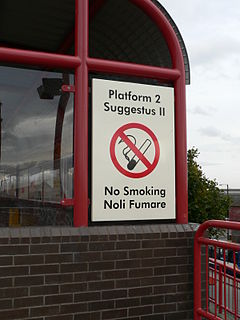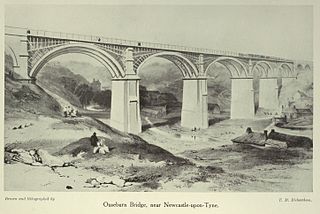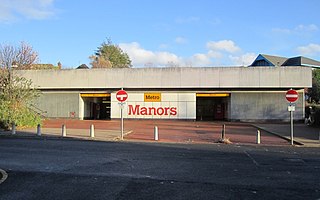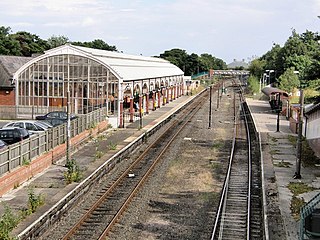
The Metropolitan Borough of North Tyneside is a metropolitan borough of Tyne and Wear, in North East England, and is part of the Tyneside conurbation. The borough council's main office is at Cobalt Business Park in Wallsend. The local authority is North Tyneside Council.

The Tyne and Wear Metro is a light rail network linking South Tyneside and Sunderland with Gateshead, Newcastle upon Tyne, North Tyneside and Newcastle Airport. The network opened in stages from August 1980, and now serves a total of 60 stations, with two lines covering 48.2 miles (77.6 km) of track.

The North Tyneside Steam Railway and Stephenson Steam Railway are visitor attractions in North Tyneside, North East England. The museum and railway workshops share a building on Middle Engine Lane adjacent to the Silverlink Retail Park. The railway is a standard gauge line, running south for 2 miles (3.2 km) from the museum to Percy Main. The railway is operated by the North Tyneside Steam Railway Association (NTSRA). The museum is managed by Tyne and Wear Archives and Museums on behalf of North Tyneside Council.

Longbenton is a station on the Tyne and Wear Metro, serving Longbenton in North Tyneside and High Heaton in Newcastle upon Tyne. The station joined the network in August 1980, following the opening of the line between Haymarket and Tynemouth – the first stage of the network to open.

Howdon is a station on the Tyne and Wear Metro, serving Howdon in North Tyneside. The station joined the network in November 1982, following the opening of the line between Tynemouth and St. James.

Cullercoats is a station on the Tyne and Wear Metro, serving Cullercoats and Marden in North Tyneside. The station joined the network in August 1980, following the opening of the line between Haymarket and Tynemouth – the first stage of the network to open.

Wallsend is a station on the Tyne and Wear Metro, serving Wallsend in North Tyneside. The station joined the network in November 1982, following the opening of the line between Tynemouth and St. James.

West Monkseaton is a station on the Tyne and Wear Metro, serving Monkseaton and Wellfield in North Tyneside. The station joined the network in August 1980, following the opening of the line between Haymarket and Tynemouth – the first stage of the network to open.

The Tyneside Electrics were the suburban railways on Tyneside that the North Eastern Railway and the London and North Eastern Railway electrified using the third rail system. The North Tyneside loop was electrified from 1904 onwards and formed one of the earliest suburban electric networks; the South Tyneside line to South Shields via Pelaw was electrified in March 1938. British Railways converted these lines to diesel operation in the 1960s: the line to South Shields in January 1963 and the North Tyneside lines in June 1967 when the electrical supply infrastructure and the rolling stock had become life expired. In addition, the system was losing passengers and suffering from costly vandalism. Since the late 1970s, much of the system has been converted to form the Tyne and Wear Metro.

The Newcastle & North Shields Railway opened in June 1839 from a temporary terminus in Carliol Square in Newcastle upon Tyne to North Shields. The railway was absorbed by the Newcastle & Berwick Railway in November 1844. The Newcastle & Berwick Railway was itself absorbed by the York, Newcastle and Berwick Railway, and this became part of the North Eastern Railway in 1854.
The Blyth and Tyne Railway was a railway company in Northumberland, England. It was incorporated in 1853 to unify several private railways and waggonways that were concerned with bringing coal from the Northumberland coalfield to Blyth and to the River Tyne. Over the years it expanded its network to include Ashington, Morpeth and Tynemouth. As coal output increased the company became very prosperous in hauling the mineral to quays for export, and in addition a residential passenger service based on Newcastle built up.

Jesmond is an underground station on the Tyne and Wear Metro, serving Jesmond in Newcastle upon Tyne. The station joined the network in August 1980, following the opening of the line between Haymarket and Tynemouth – the first stage of the network to open.

Tynemouth is a station on the Tyne and Wear Metro, serving the Tynemouth area of North Tyneside. The Tyne and Wear Metro station at Tynemouth was opened as a terminus station in August 1980, for services between Haymarket and Tynemouth. November 1982 saw the commencement of through services, following Metro's extension from Tynemouth to St. James.

Central Station is an underground station on the Tyne and Wear Metro, serving the southern part of Newcastle City Centre. The Metro station was opened in November 1981, and refurbished in 2015–2016.

Manors is an underground station on the Tyne and Wear Metro, serving the city centre, Manors and Shieldfield in Newcastle upon Tyne. The station joined the network in November 1982, following the opening of the line between Tynemouth and St. James. The station is located a short walk away from the National Rail station at Manors, which is situated on the East Coast Main Line.

South Shields railway station was the main railway station for South Shields, in Tyne and Wear, North-East England. The station was located on Mile End Road in the town centre. The station was opened by the NER in 1879 as the terminus of their newly extended Newcastle and South Shields Railway branch from Pelaw via Hebburn and had two platforms and an ornate overall roof.

Monkseaton is a station on the Tyne and Wear Metro, serving Monkseaton and Whitley Bay in North Tyneside. The station joined the network in August 1980, following the opening of the line between Haymarket and Tynemouth – the first stage of the network to open.

Whitley Bay is a station on the Tyne and Wear Metro, serving the Whitley Bay area of North Tyneside. The Tyne and Wear Metro station at Whitley Bay was opened in August 1980.

Tyne and Wear is a metropolitan area covering the cities of Newcastle upon Tyne and Sunderland, as well as North and South Tyneside, Gateshead and Washington.
Walker railway station, known as Low Walker until 1889, served Walker, a residential suburb of Newcastle, in Tyne and Wear. It was situated on the North Eastern Railway's Riverside Branch from Newcastle to Tynemouth via Carville. The station served as a passenger halt and goods depot for shipping companies such as Armstrong Whitworth and other land-based companies including the Northern Wood Haskinizing Company.


















